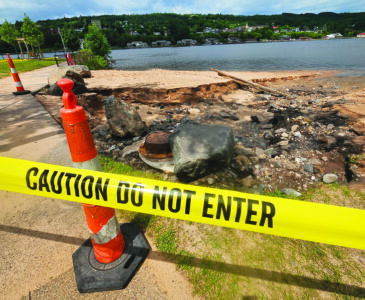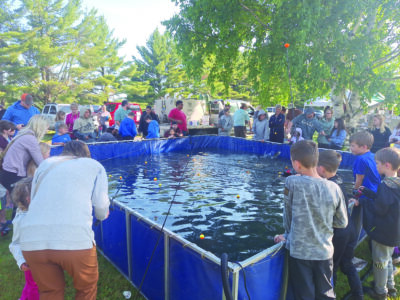Eastern runs out at Ripley

Kali Katerberg/Daily Mining Gazette Flooding damage at the Mont Ripley Ski Area on the Powderstash and Deer Track Trails.
HANCOCK — Flood damage will not affect the winter sports season at the Mont Ripley Ski Area, according to the venue’s general manager.
“We’re going to open. We’re going to make snow. We’re going to turn lifts on. We’re going to have lessons. We’re going to have races,” said Nick Sirdenis, Mont Ripley’s general manager.
Out of 24 trails on the hill, only the ones on the east — Powderstash and Deer Track Trail — were taken out by the June 17 flooding.
Though most runs remain open, the damaged two may not be repaired until next year and have an undetermined repair cost. Along with many other entities affected by the flood, Ripley is waiting for a state of disaster declaration by the federal government.
“We probably won’t have those two trails. They’re the two farthest trails to the east or looking up the hill to the right, and those were very popular trails. It’s going to hurt us, there’s no doubt about it, but we can’t make magic,” Sirdenis said. “It’s something that’s going to take time to fix, and so we will be without those two trails for the season.”
Despite the challenges, he expects skiers won’t be deterred.
In the flooding, Powderstash Trail was stripped down to bedrock but both trails share a return road, intersecting and continuing down the hill. That intersection has been washed out closing both, for the time being, Sirdenis explained.
“There is a pretty good sized hole left on the hill,” he said.
The Deer Track Trail is an unfortunate loss for the hill as it was one of the few easy runs and for employees the easiest way to get up the hill in either ATVs or by truck.
The trial failed due to the sheer volume of water coming down from the north that overwhelmed ditches and culverts, he said.
“The erosion ditches that were in that originally were about three feet deep and two feet wide and now they’re 12 feet deep and 20 feet wide. You can see it everywhere, it just really scoured that down,” Sirdenis said.
When the water reached the culverts, the issue wasn’t entirely the fault of the water but the rock moving with it that plugged the pipes. On the other hand, the water that fell on the other portions of the hill was more easily managed.
Emergency fixes are already in place in case of another large rainfall. A large ditch was added and lined with rock in place of the culvert.
“That was the very first thing to stabilize it and make it safe,” Sirdenis said.
The fix was put in place by July 1 and managed the July 12 flooding. It remains in place for other large storms.
Next up for Ripley is getting engineering bids, work bids and waiting to see if disaster funding will be coming from the Federal Emergency Management Agency.
“Everything is fixable. I think it’s fixable. It’s just a matter of time and money,” Sirdenis said.





